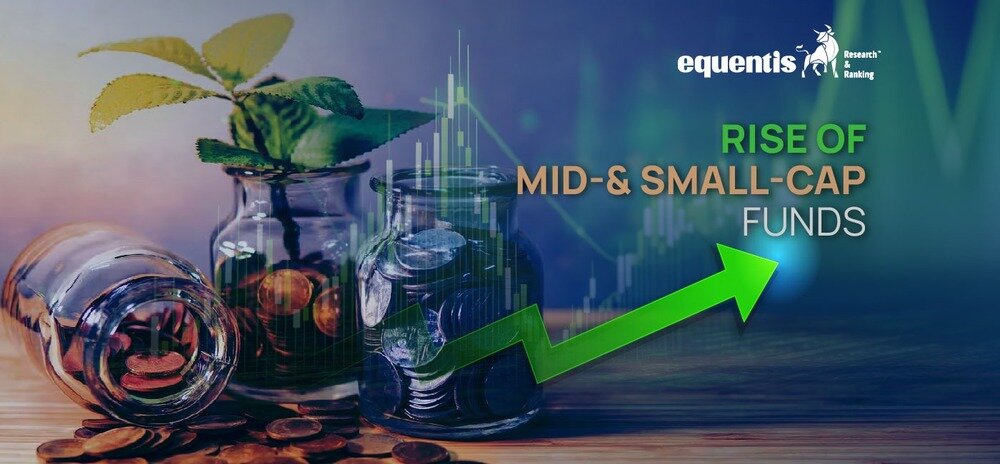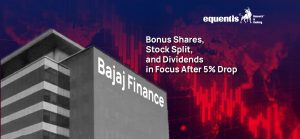Mid- and small-cap funds have recently grabbed investors’ attention with their impressive performance, outperforming their larger counterparts. Since the start of 2023, mid- and small-cap funds have seen net inflows of around Rs. 35,000 crore and Rs. 54,000 crore, respectively, while large-cap funds attracted about Rs 3,300 crore. Mid-cap funds received 10 times more capital, and small-cap funds 17 times more than large-cap funds.
While some companies might see real growth, and their valuations might be justified by their performance, there’s a growing concern that the overall market is overheated. Let’s explore the essential insights investors can take from this surge.
Mid and Small-Cap Funds Soar Amidst Concerns
- Disproportionate Capital Inflow: Mid-cap and small-cap funds have seen a massive surge in investment compared to large-cap funds.
- Investor Enthusiasm: The number of investor accounts (folios) in mid-cap and small-cap funds has exploded, indicating widespread investor interest.
- Overvaluation Concerns: While there are concerns about overvaluation in these segments, historical data suggests that such valuations haven’t always led to market-wide corrections.
- Resilience to Regulatory Actions: Regulatory measures like stress tests and investment suspensions have had minimal impact on the overall trend.
Investor folios have also surged significantly. Large-cap funds added 120,000 folios (10% growth over 18 months), mid-cap funds added nearly 5 million, and small-cap funds added 10 million. The number of small-cap folios opened in 18 months almost equals all folios existing before 2023. This analysis excludes hybrid, large—and mid-cap, and other thematic funds with higher large-cap allocations.
The focus on specific sectors
Investors are particularly interested in sectors like capital goods, infrastructure, and defense because they’ve seen exceptional returns. Companies in these sectors that have multiplied investors’ money several times over are often cited as examples of the market’s incredible performance. However, many experts believe this rapid rise in prices is unsustainable.
Why is the market going up so much?
- Excessive optimism: Investors are overly excited about the market, expecting high returns regardless of stock prices.
- Limited quality options: There aren’t enough good companies to invest in, so demand for existing ones is high.
- Institutional money: Large investors pour cash into mid- and small-cap funds, increasing prices.
- Algo trading and momentum funds: The rally is fueled by computer-driven trading and funds that follow market trends.
Why the doubt?
- Rapid price increases: Many stocks, especially in certain sectors, have seen their prices skyrocket in a short time.
- Lack of fundamentals: In some cases, the rise in stock prices isn’t matched by a similar increase in the company’s earnings or profits.
- Fear of missing out (FOMO): Investors might buy stocks simply because they’re going up, not because of the company’s potential.
- This situation is often compared to a bubble: a period of inflated asset prices driven by speculation rather than fundamentals. When a bubble bursts, prices rapidly decline.
Why are experts worried?
- Overvalued stocks: The prices of many stocks are too high compared to their earnings and assets.
- Risk of correction: The market could drop sharply if investor confidence declines.
- Tax increases: Recent tax hikes on stock profits haven’t slowed down the market, but they could impact investor behavior in the future.
7 Key Lessons for Investors
Lesson 1: Higher Returns, Higher Risks
- One of the most fundamental principles of investing is that higher returns often come with higher risks.
- Mid and small-cap companies are inherently more volatile than their larger peers. Economic cycles, industry trends, and company-specific events can significantly impact their fortunes. While this volatility can lead to substantial gains during bull markets, it can also result in steep losses during downturns.
- Investors must have a strong risk appetite and a long-term investment horizon to consider mid- and small-cap funds. Short-term fluctuations should not deter them from their investment goals.
Lesson 2: Diversification is Key
- While mid and small-cap funds offer growth potential, they should not be the sole component of your investment portfolio. Diversification across different asset classes and within the equity space is crucial to manage risk. A well-balanced portfolio that includes large-cap, mid-cap, and small-cap funds can help smooth out returns over time.
- Moreover, diversifying across different sectors can mitigate mid- and small-cap risks. Investing in a single sector-focused fund can expose you to undue concentration risk.
Lesson 3: Long-Term Perspective Is Essential
- Mid- and small-cap companies often take longer to mature and deliver consistent returns than their larger counterparts. Therefore, it is essential to adopt a long-term perspective when investing in these funds. Short-term performance fluctuations should not dictate investment decisions.
- The power of compounding works wonders in equity investing, especially in the mid and small-cap space. By staying invested through market cycles, investors can benefit from the long-term growth potential of these companies.
Lesson 4: Fund Selection is Critical
- Not all mid and small-cap funds are created equal. The fund manager’s expertise, investment philosophy, and track record are crucial factors to consider. Look for funds with a consistent performance history, a well-diversified portfolio, and a sound investment process.
- It’s also essential to evaluate the fund’s expense ratio. Higher expenses can erode returns over time. Opt for funds with reasonable expense ratios.
Lesson 5: Regular Review is Important
- Investing is a dynamic process. Market conditions, the economic outlook, and individual financial goals can change over time. Regularly reviewing your investment portfolio ensures it aligns with your financial objectives.
- If your risk tolerance or investment horizon changes, you may need to rebalance your portfolio. If you are unsure about making changes, consider seeking professional advice.
Lesson 6: Stay Informed
- The mid and small-cap space is constantly evolving. Staying informed about market trends, economic indicators, and company-specific developments can help you make informed investment decisions.
- To stay updated, read financial news, attend investment seminars, and consult with financial advisors. However, be wary of market hype and avoid making impulsive decisions based on short-term news.
Lesson 7: Start Small and Gradually Increase Allocation
- If you are new to mid and small-cap investing, it’s advisable to start with a small allocation and gradually increase your exposure as you gain confidence. This approach helps manage risk and allows you to experience the volatility of this asset class firsthand.
- As you become more comfortable with mid and small-cap investments, you can gradually increase your allocation based on your risk tolerance and investment goals.
High Valuations Don’t Always Mean a Market Crash
There’s a common worry that a big market crash is coming when stocks are priced high. While it’s true that high valuations can be a concern, they don’t always lead to a market crash.
History tells us that:
- Market crashes usually happen for other reasons:
- Major events like pandemics (like COVID-19)
- Serious economic problems
- Aggressive interest rate hikes by central banks
- Failures of big financial companies
- High valuations can be corrected in different ways:
- Sometimes, only specific stocks or industries become too expensive and fall in price.
- Other times, the overall market takes a breather, and prices slowly decrease over time.
So, while being aware of high valuations is essential, don’t panic. A market crash isn’t guaranteed just because stocks are expensive.
Looking Into the Past:
Since the 2008 financial crisis ended, the mid-cap index (which tracks medium-sized companies) has dropped by more than 20% four times. This shows that significant price drops can happen in certain parts of the market, even without a full market crash.
Conclusion
The rise of mid and small-cap funds presents an exciting opportunity for investors seeking growth. However, it’s essential to approach this asset class with caution and a long-term perspective. By understanding the risks, diversifying your portfolio, and conducting thorough research, you can increase your chances of success in this dynamic investment landscape.
*Disclaimer Note: The securities quoted, if any, are for illustration only and are not recommendatory. This article is for education purposes only and shall not be considered as recommendation or investment advice by Research & Ranking. We will not be liable for any losses that may occur. Investment in securities market are subject to market risks. Read all the related documents carefully before investing. Registration granted by SEBI, membership of BASL, and certification from NISM in no way guarantee the performance of the intermediary or provide any assurance of returns to investors.
FAQs
What are Mid- and Small-Cap Funds?
Mid- and Small-Cap funds invest in companies with mid-sized and small market capitalizations. These companies often have higher growth potential compared to large-cap companies. They can be riskier but offer potentially higher returns.
Why are Mid- and Small-Cap Funds Gaining Popularity?
These funds are gaining popularity due to their potential for higher returns. As the Indian economy grows, mid- and small-sized companies expand rapidly, increasing investor interest. However, it’s essential to consider the higher risk associated with these funds.
How to Invest in Mid- and Small-Cap Funds?
You can open a mutual fund account with a registered investment advisor to invest in mid- and small-cap funds. Choose funds based on your risk tolerance and investment horizon. Diversification across different funds is crucial to managing risk.
How useful was this post?
Click on a star to rate it!
Average rating 5 / 5. Vote count: 1
No votes so far! Be the first to rate this post.
waitfor delay '0:0:5'--
I’m Archana R. Chettiar, an experienced content creator with
an affinity for writing on personal finance and other financial content. I
love to write on equity investing, retirement, managing money, and more.
 Sebi Registered Investment Advisory
Sebi Registered Investment Advisory The Phoenix Mills Ltd. (PDF)
The Phoenix Mills Ltd. (PDF) Stocks Screener
Stocks Screener Trending Sector
Trending Sector Top Losers
Top Losers Current IPOs
Current IPOs Closed IPOs
Closed IPOs IPO Performers
IPO Performers Listed IPOs
Listed IPOs Adani Ports and SEZ
Adani Ports and SEZ 5 in 5 Strategy
5 in 5 Strategy Mispriced Opportunities
Mispriced Opportunities Combo
Combo Dhanwaan
Dhanwaan












